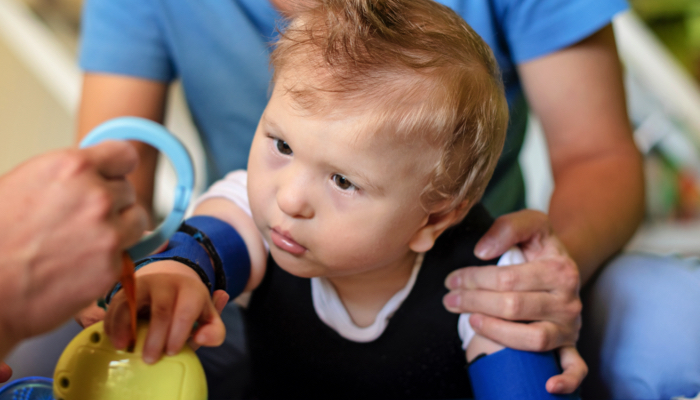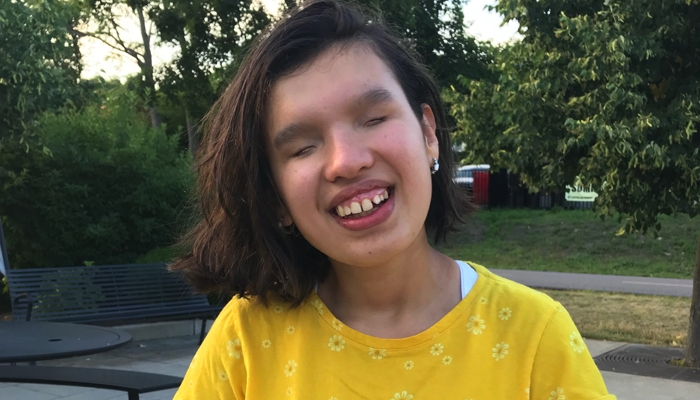Wave at the Blind Lady!

By Kathy Seven Williams
Helping Your Blind Child Interact with a Sighted World and Helping the Sighted World Interact with Your Blind Child
Over the decades I have found that people do best when you give them an option of what might be a good thing to do. People often want to be friendly or helpful or interact with another person, but may not know how. It took me until I was in my 40’s to develop the ease to simply say, “I cant see you and I don’t recognize people. Would you please tell me who you are when you approach me?”
Now that isn’t such a hard thing to say. Wouldn’t you think it would just come trippingly off the tongue? But it was like asking for their first born. I always felt it would be taken to mean I didn’t care enough about someone to find a way to recognize them. I knew about these blind people who could keep a catalog of every voice they’d ever heard and know exactly who was speaking from two rooms away. Not me! I’m a mere mortal. Well, once I learned to ask for a little help, I discovered people are pretty quick on the uptake and are pretty great about getting the idea, but it’s still hard for me. Asking for assistance by saying I can’t see such and such could you please help me with it? has gotten a bit easier over the years.
So how do you help your child learn to do this? You begin by facilitating a path for people to follow to interact with your child. Tell them what they should do when they first meet your child. My folks, unfortunately, used to just say, “She doesn’t see properly.” This was more an explanation for why I had embarrassed them than a way to open the door for the other person to approach me more appropriately. I always felt so bad because I was trying so hard to do it all right. One of the great gifts you folks can give your wee ones is the ease and skill to instruct the public on what will work in an interaction with them.
When my kids were in high school, a vanload of my daughters friends went by while I was standing at the bus stop. One of her friends waved to me then later asked if I was mad at them because I didn’t wave back. Traci just laughed at him and he realized his oops. From then on, the kids would call to me from their cars, “Wave at the blind lady!” After we moved out of state a couple of them even phoned just to say hey, but what they really said was, “I just called to wave at the blind lady.” Then they would bring me up to date on their lives.
Unfortunately we have to teach one person at a time because if you haven’t experienced something it’s really hard to imagine it accurately and people seem to imagine blindness with horror and fear or sympathy and condescension much of the time.
It’s really good to start giving your kids words to speak of their blindness early so they aren’t left bewildered about people and interactions. I don’t think there’s anything wrong with explaining to your child that because of the way his eyes work they don’t look at other people the way the people expect them to. He can learn to work extra hard at orienting his body and face toward the person he wants to speak with to make up for some of this confusion of face behavior.
One of the things I whined at most growing up was when my parents would make me look at what I was doing even though I couldn’t see it. It seemed totally stupid to me and like they just didn’t want to admit I couldn’t see stuff. But in a sighted world the less different you are the better you are accepted and included. By looking like I was looking people were less uncomfortable around me and I was included more. In later life this goes for jobs and activities as well as social events.
It may not be right, but it is true that people would rather you don’t look blind because it makes them uncomfortable. Too bad for them aside, people aren’t going to do what makes them uncomfortable—that’s just real. Of course, the down side of looking more or less “normal” is that people don’t know I can’t see and don’t offer the help I may need freely so I have to work harder to get it. But in the long run I think I miss out on far less this way.
Posted with permission from Kathy Seven Williams. Visit Kathy’s web site
Read this article in Arabic: حيوا-السيدة-العمياء
Related Posts

Eye Conditions and Syndromes, Support, Visual Impairment
Coping with a Diagnosis: Emotional Support for Families with Visually Impaired Children
Families with emotional support are more resilient. Learn how to establish emotional support with peers, professionals, and the community to help your family thrive.

Special Needs, Visual Impairment
Why Early Intervention Is Critical for Blind Children
Children diagnosed with visual processing disorders, low vision, or blindness need specialized treatment. Early intervention programs can help.

Eye Conditions and Syndromes, Visual Impairment
Anophthalmia: Navigating the Path from Diagnosis to Adaptation for Parents and Their Children
Anophthalmia is a rare disorder that results in childhood blindness. Early intervention services are important to help your baby maximize their potential.